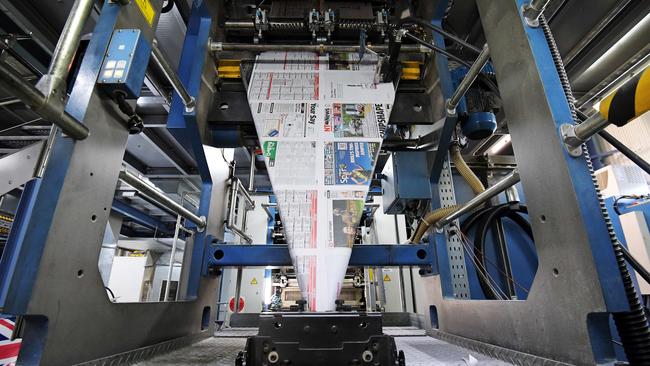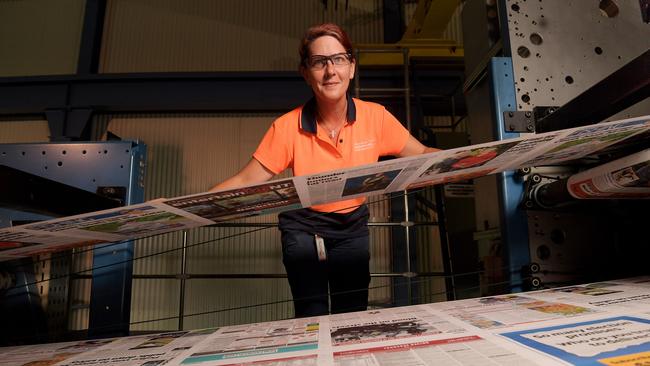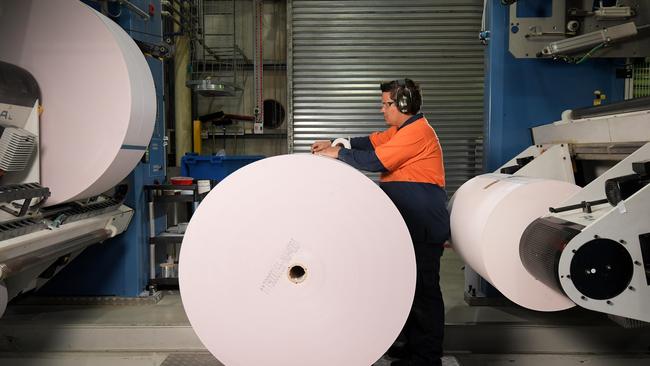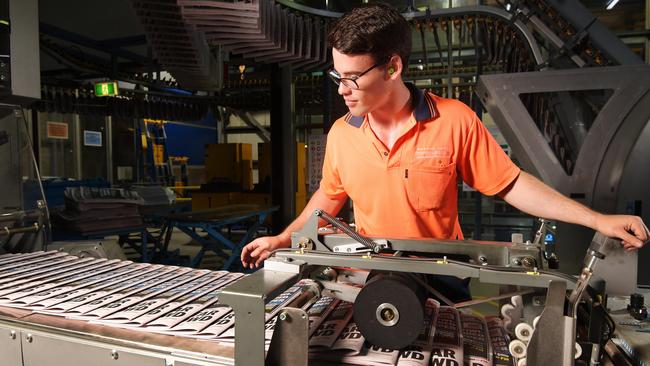IN the late evening, when most Territorians are tucked away in bed, the NT News printing press, making a sound as absurd and unsavoury as the Territory’s latest political scandal, begins to run at full speed.
What’s happening at that moment is something between ‘paper staining’, as veteran pressman Russell Kemp puts it, and miracle work.
In the hours leading up to this moment, journalists have written stories, editors and designers have composited them onto a page, copyeditors have checked for errors, and a digital file — the newspaper’s DNA — is sent to the pressroom computer.
From here, photographic, ink receptive images are burned via laser onto blank printing plates
The plates are curved around a series of rollers and put into the press, where they filter through four different colour inks — cyan, magenta, yellow and black.
● SEE THE GALLERY OF PHOTOS HERE
Ink is applied to the plate, and the plate transfers its image across to two blanket cylinders.
When the noise inside the print room becomes overwhelming, reams of paper are whirring between these cylinders, which press against the paper to make the final print.
These reams of paper, now inked, dried and rolled into sheets kilometres long, are then cut and folded into tabloid size. Each print copy is suspended via a gripper conveyor belt, one by one, to bundling machines. These bundles end up on delivery trucks.

When copies of the Centralian Advocate, which are printed on the McMinn St press, are loaded for delivery, the trucks take off down the Stuart Hwy on what is believed to be the longest newspaper delivery run in the world.
Mike O’Neill, a pressman at the NT News since 2001, believes this process remains a mystery to most news readers. “People think when they get a paper, it goes on the back of a truck and onto the newsstand,” he said.
“But the process from file to press to having the paper in someone’s hand is a whole big chain of events that no one really understands.”
Says Kemp: “People ask, ‘what do you do? Do you still use the lead type? There is no concept of what it is a printer does. I guess it is a kind of mystery. I call us The Shoemaker’s Elves, because the paper is there every morning when people get out of bed.” Impersonating a reader picking a paper up off their lawn, Kemp mused: “Oh, the paper is here, I wonder how this happened?”

THE pressroom staff arrive for their night’s work at 5pm.
The workplace of Benjamin Ngaia, Russell Kemp, Errol McKewin, Mike O’Neill and John Tomsett is one of heavy machinery, ceaseless noise and intractable deadlines.
You soon learn, hanging around a printing press, that this is a complicated gig, and one almost impossible to explain in a sensible amount of time.
Inside the printing press, there are thousands of traps for the pressman, but in less than 12 hours, thousands on Territorians will be reading their print.
Precision accuracy, deft problem solving and, in the case of the NT News print staff, 136 combined years of pressroom experience, ensures the newspaper is unbundled for Territorians to read alongside their morning Joe every single day,
To do so, this unit of highly skilled operators splits up into four different roles: the plate room operator (in charge of checking plates and making sure they are placed properly on the press), the folder operator (who oversees the general running of the press and ensures papers coming off the press are up to standard), the colour operator (controls ink density, ink/water balance and the overall look of the paper) and the reel stand operator, who prepares the huge newspaper reels for the print run which, if rolled out, could run from the pressroom to Palmerston.
“Every job we do is precise and important,” explains Ngaia, the press hall line leader who heads up the five-man crew.
“We were trained when we were young that anyone can print a newspaper that looks okay, but for us it’s about precision and quality.”
A pressman, over many years, is schooled in the art of precision, and is, every night, examined on what they’ve learned.
“When something goes wrong in the print room, just by process of elimination we can identify what has happened, and that comes with years and years of experience,” Ngaia says.
After starting off as a printing apprentice at the age of 15, Ngaia can now, at glance, take a newspaper off the press and localise any of the bleeds, blemishes or umpteen printing errors that may occur during print to a microscopic area on the monolithic printing press.
“That piece of paper that we grab will tell us everything we need to know,” he said.
“It shows the skill of a printer to work out not just that it doesn’t look right but why it doesn’t look right, and then they can get back to the source of the problem.”
Kemp, who started as a pressman in Darwin in 1992, has been printing since he scored a job at the Shepparton News in Victoria in 1975.
Before then, Kemp was tethered to the darkroom in a photo lithography job. At the time, he could see a more exciting future emerging in the print room.
“In the darkroom we only did black and white and there was no chance to expand anything,” he says.
During his apprenticeship with Shepparton News, Kemp quickly found an affinity for life as a pressman.
“I liked the hands on work and enjoyed the guys working on the press — they were loose cannons and easy to get along with,” he says.
“I still enjoy printing, it’s been a good trade. Working on the press challenges you. If something goes wrong, you must work out how to fix it quick, and through that you learn a lot which you can pass onto other people.”

IN October 2010, at a time when the floor was falling out from underneath the newspaper industry, the NT News upgraded its printing press.
The multimillion-dollar investment would mean full colour printing for the paper, and production efficiencies across the pressroom.
“We are basically standing on the Ferrari of printing presses,” explains Ngaia, scanning the pressroom from the third level balcony, the sun setting across Darwin Harbour at his back. “It was cool to think as an apprentice I actually drove a multimillion-dollar piece of machinery before I could drive a car.”
Says Kemp of life inside the modern printing press: “It’s a lot easier now.
“Sometimes if there’s a failure you have to go back to the old days, but the technology change has been amazing from manual to fully automatic.”
Ngaia jokes that, compared to the printing days of yore, pressman joke they are “now glorified button pushers and switch flickers”.
“I grew up on a press that was very manual labour, nothing was automated, whereas here everything can be moved with the press of a button.”
While automation has simplified things for the printer and contributed to a greater overall consistency in print product, it has also put printers out of a job. “Automation is amazing for quality, but not so much for the printer,” Ngaia says.
“Through automation we are exposed to more multi-tasking, you can work quicker and produce a better product.
“But where it used to take four people to adjust the registration (maintaining precision alignment and placement of ink onto the page) all night, now it can be done by one operator on a screen.”
The increased efficiency of the new press installed in 2010 would allow the company to produce Sunday to Friday editions in a single print run, and the Saturday edition in three runs instead of five.
“That’s why, back in the old days, there were heaps of us in a crew,” Ngaia says.
“Now, we’re down to a couple of blokes.”

IN a small Queensland town called Ayr 50 years ago, John Tomsett began cutting his teeth “on the hot metal”.
Tomsett, who has been working the NT News press since 2006, is in equal measure nostalgic for the good old days and in awe of how far the printing caper has come.
“I loved it then, and I still do now,” he says. “The technology and the advancement — who had the brains to build something like this?”
Like the rest of the print room, Tomsett has gone toe-to-toe with the spectre of obsolescence, adapted to new technology and come out the other side with a dignified pride in his work.
Back in the days when the print was black and white but workplace behaviour was less clearly defined, Tomsett, after a dust-up at the Townsville pressroom, decided to play a practical joke.
After hearing his mate was going to the bathroom, Tomsett booby trapped it with a bucket of water atop the dunny door. When the general manager slipped into bathroom first, Tomsett thought his printing career might be cut short.
Luckily for NT News general manager Greg Thomson, the pressmen here all get along. “It’s a really good group of guys,” Kemp says.

AS news across the world has democratised and globalised, the printing world has shrunk.
Pressmen like those who work at McMinn St, like journalists who survived the catastrophic redundancy rounds of the new media landscape, are crocodiles of the industry who have staved off extinction.
Ngaia and McKewin moved over 3500km kilometres from Warwick, Queensland to Darwin after the Warwick printing press, just a few years after the Toowoomba press, closed its doors.
“I’ve already been through one redundancy and I was very lucky to get a transfer to Darwin,” Ngaia says.
“If you lose your position in the printing industry, there’s not much hope of getting it back.”
Pressmen like Ngaia are keenly aware of the challenges technology presents to the printing industry as print sales continue their slow decline and digital readerships rise.
“Errol and I are in our early 30s, and we’ve still got another 30 years of our working lives ahead of us,” he says.
“I hope and pray every day that I can stay printing. It’s unnerving all the time. You just hope you’re never going to get that bad news that we’re going to get shut down. It’s not that easy in a shrinking industry to find a good job.”
But as the industry contracts, the value of the printer’s craftsmanship and intellectual property grows.
“There’s over 130 years of experience between five people, and when guys retire or are forced out, that knowledge of those presses goes with them,” Ngaia said.
“This stuff isn’t written down, it’s like an ancient language.”
For Ngaia, being a highly skilled expert in a niche industry is something to be proud of.
“We like printing, it’s one of the oldest trades in the word,” he says.
“In printing you use your head, your hands, and you get to create something every night.
“Who else can say that they get to read the news first?”

Add your comment to this story
To join the conversation, please log in. Don't have an account? Register
Join the conversation, you are commenting as Logout
Mental health advocate uses personal pain as strength
The award-winning mental health facilitator and advocate is passionate about breaking cycles of violence and is not afraid to use her own painful story to do it.
Unpacked: The Kumanjayi Walker coronial inquest findings
After almost three years since it began, the inquest into the death of Kumanjayi Walker has finished. So, what did Coroner Elisabeth Armitage find out – and will it bring change?